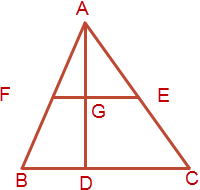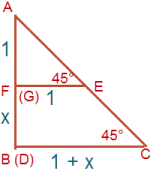Question 1
SSC-CGL 2018 June 4 Shift 1
In a triangle ABC, the points F and E respectively on AB and AC sides are such that FE || BC and FE divide the triangle into two parts with equal area. If AD ⊥ BC and AD intersect FE at point G, then GD: AG =?

Solution in Detail
Observe in the triangles AFE and ABC
[1] $\displaystyle \angle F = \angle B$ [given FE || BC]
[2] $\displaystyle \angle E = \angle C$ [given FE || BC]
$\displaystyle \therefore $ by AA rule $\displaystyle \Delta AFE \sim \Delta ABC$
Given $\displaystyle \frac{\text{ar(ABC)}}{\text{ar(AFE)}} = 2$
REMEMBER: The ratio of the areas of two similar triangles is equal to the square of the ratio of any pair of their corresponding sides and altitudes$\displaystyle \therefore \bigg(\frac{AD}{AG}\bigg)^2 = \frac{\text{ar(ABC)}}{\text{ar(AFE)}} = 2$
$\displaystyle \therefore \frac{AD}{AG} = \sqrt 2$
$\displaystyle \implies \frac{(AG + GD)}{AG} = \sqrt 2$
which gives $\displaystyle \frac{GD}{AG} = (\sqrt 2 - 1) $
$\displaystyle \therefore (\sqrt 2 - 1) : 1 \:\underline{Ans}$
Solution by Alternate Method
Because of similarity,
$\displaystyle \frac{BC}{FE} = \frac{AD}{AG} = k \text{. . . (1)}$
Given, $\displaystyle\text{ ar(ABC)} = 2 \times \text{ar(AFE)}$
For a triangle, area = 1/2 x base x height
$\displaystyle \therefore \frac12 \overline{BC} \cdot \overline {AD} = 2 \cdot \frac12 \cdot \overline {FE} \times \overline{AG}$
$\displaystyle \therefore \overline{BC} \cdot \overline {AD} = 2\cdot \overline {FE} \times \overline{AG}$
Put BC and AD from (1) above
$\displaystyle \therefore k\cdot FE \cdot k\cdot AG = 2\cdot \overline {FE} \cdot \overline{AG}$
$\displaystyle \implies k = \sqrt 2$
by (1) $\displaystyle \frac{AD}{AG} = k = \sqrt 2$
$\displaystyle \implies \frac{AG + GD}{AG} = \sqrt 2$
which gives $\displaystyle \frac{GD}{AG} = (\sqrt 2 - 1) $
$\displaystyle \therefore (\sqrt 2 - 1) : 1 \:\underline{Ans}$
Solution 3
[the technique in this method can sometimes be used for solving tough questions. but you will have to spend time to grasp it.]The result is independent of the type of triangle. So any triangle can be taken for verification.
Take an isosceles right angled triangle such that AF = 1 as shown.

Let $\displaystyle \overline {BF} = x$
Given, $\displaystyle\text{ ar(ABC)} = 2 \times \text{ar(AFE)}$
$\displaystyle \therefore \frac12 \cdot (1 + x) \cdot (1 + x) = 2 \cdot \frac 12 \cdot 1 \cdot 1$
Simplifying, $\displaystyle x = (\sqrt 2 - 1)$
$\displaystyle \therefore \frac{\overline{GD}}{\overline{AG}} = (\sqrt 2 - 1) : 1 \:\underline{Ans}$

This Blog Post/Article "(solved)Question 1 SSC-CGL 2018 June 4 Shift 1" by Parveen is licensed under a Creative Commons Attribution-NonCommercial-ShareAlike 4.0 International License.